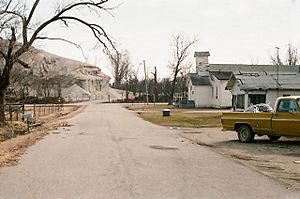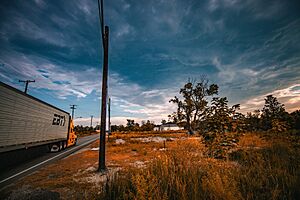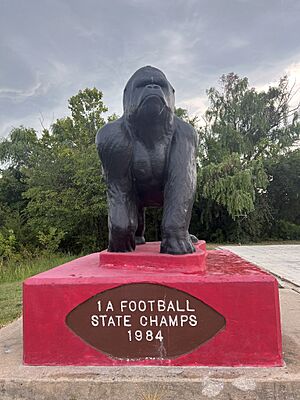Picher, Oklahoma facts for kids
Quick facts for kids
Picher, Oklahoma
|
|
|---|---|
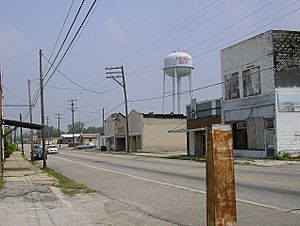
A view looking north along Connell Ave, which was the main business district, 2007. The Picher Water Tower stands in the background.
|
|
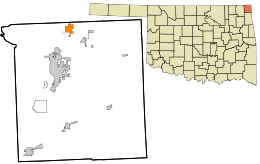
Location within Ottawa County showing former municipal boundaries
|
|
| Country | United States |
| State | Oklahoma |
| County | Ottawa |
| Area | |
| • Total | 2.2 sq mi (5.8 km2) |
| • Land | 2.2 sq mi (5.8 km2) |
| • Water | 0.0 sq mi (0.0 km2) |
| Elevation | 823 ft (251 m) |
| Population
(2010)
|
|
| • Total | 20 |
| • Density | 9.1/sq mi (3.4/km2) |
| Time zone | UTC-6 (Central (CST)) |
| • Summer (DST) | UTC-5 (CDT) |
| ZIP code |
74360
|
| Area code(s) | 539/918 |
| FIPS code | 40-58550 |
| GNIS feature ID | 1096611 |
Picher is a ghost town in Ottawa County, Oklahoma. It used to be a city. For over 100 years, it was a major center for mining lead and zinc. This area was part of the Tri-State Mining District.
Years of mining underground made most of Picher's buildings unsafe. Huge piles of toxic metal-filled waste, called chat, were left all over the area. People found out about the risk of buildings collapsing. They also learned about polluted groundwater and health problems from the chat piles. Because of this, Picher was added to the Tar Creek Superfund site list in 1983. This was done by the US Environmental Protection Agency (EPA).
The state worked to clean up the area. But a study in 1994 showed that 34% of children in Picher had lead poisoning. This could cause brain problems for life. Eventually, the EPA and Oklahoma decided that everyone had to leave. The government bought out properties to help people move away.
A study in 2006 showed that 86% of Picher's buildings were unsafe. They could collapse at any time. In May 2008, a strong EF4 tornado hit Picher. It destroyed 150 homes. This made the remaining people leave even faster.
On September 1, 2009, Oklahoma officially closed Picher as a city. Its population dropped from 1,640 in 2000 to just 20 in 2010. The government continued to buy homes. By January 2011, only a few homes and one business remained. Their owners did not want to leave. Most other buildings were planned to be torn down. Picher is one of the few places in the world that had to be evacuated because of mining damage.
The closest towns to Picher are Commerce, Quapaw, and Miami, Oklahoma. Nearby ghost towns include Cardin, Treece, and Douthat.
Contents
History of Picher
Mining Begins
In 1913, people found lead and zinc in the Picher area. This was when the Tri-State district was growing. Mining quickly started. A town grew up very fast around the new mines. It was named Picher after O. S. Picher, who owned the Picher Lead Company.
The city officially became a town in 1918. By 1920, Picher had 9,726 people. The most people ever lived there in 1926, with 14,252 residents.
The Picher area became the best lead-zinc mining spot in the Tri-State district. It produced over $20 billion worth of ore between 1917 and 1947. More than half of the lead and zinc used in World War I came from Picher. At its busiest, over 14,000 miners worked in the mines. Another 4,000 people worked in mining services. Many workers traveled by trolley from towns like Joplin.
Decline and Pollution Problems
After 1926, Picher's population started to shrink. This was because mining activity slowed down. By 1960, only 2,553 people lived there. Mining stopped completely in 1967. After that, no one pumped water out of the mines anymore.
This left a huge environmental problem. Contaminated water filled 14,000 abandoned mine shafts. There were also 70 million tons of mine waste and 36 million tons of sand and sludge. In 1983, the area was named part of the Tar Creek Superfund site. This was due to laws about cleaning up dangerous environmental places.
In 1994, tests showed that about 35% of Native American children in the area had high lead levels in their blood. This was a health concern. The EPA began testing soil in places where children played, like schools. They found a lot of lead and other heavy metals. Because of these dangers, the EPA and Oklahoma decided to move everyone out of Picher.
Even though some cleanup happened, the pollution was too bad. The government decided to close Picher and move its residents. This was reported in 2006. Also, many buildings were in danger of collapsing. This was because so much material had been mined from underground.
Tornado Strikes
On May 10, 2008, an EF4 tornado hit Picher. Six people died, and many more were hurt. The tornado caused a lot of damage to 20 blocks of the city. Homes and businesses were destroyed. At least 150 people in Picher were injured.
Oklahoma Governor Brad Henry sent National Guard troops to help. The tornado caused a power outage. The city had to boil its water. Since the city was already planning to close, the government did not help rebuild homes. Instead, they continued to help people move away.
Picher's Closure
Picher's post office closed in July 2009. The city officially stopped operating on September 1, 2009. By June 2009, all residents had received money from the government to move. The city was considered too toxic to live in. On the last day, the remaining residents met to say goodbye.
By November 2010, only one business and six homes were still occupied. Starting in January 2011, most remaining buildings were torn down. Gary Linderman, who owned the Ole Miners Pharmacy, said he would stay until the very last person left.
The city of Picher was officially closed on November 26, 2013. By March 2014, some abandoned buildings were still standing. These included the high school, a church, and the mining museum.
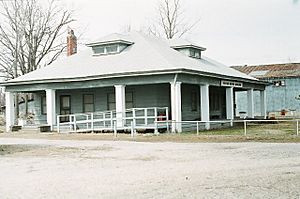
The Picher Mining Field Museum was destroyed by fire in April 2015. However, its historical items had already been moved to other museums. In March 2017, the Christian church was also destroyed by fire.
Gary Linderman, the pharmacy owner, was featured in People magazine in 2007. He promised to stay as long as anyone needed him. He died in June 2015.
The cleanup of the Tar Creek Superfund site is still happening. In 2019, the EPA, Oklahoma, and the Quapaw Nation released a plan to speed up the cleanup. Since 2015, former residents have held Christmas parades in Picher.
Geography
Picher is about 8 miles (13 km) north of Miami, which is the county seat. The city had a total area of 2.2 square miles (5.8 km2). All of this area was land.
Population Changes
| Historical population | |||
|---|---|---|---|
| Census | Pop. | %± | |
| 1920 | 9,676 | — | |
| 1930 | 7,773 | −19.7% | |
| 1940 | 5,848 | −24.8% | |
| 1950 | 3,951 | −32.4% | |
| 1960 | 2,553 | −35.4% | |
| 1970 | 2,363 | −7.4% | |
| 1980 | 2,180 | −7.7% | |
| 1990 | 1,714 | −21.4% | |
| 2000 | 1,640 | −4.3% | |
| 2010 | 20 | −98.8% | |
| 2019 (est.) | 0 | −100.0% | |
| U.S. Decennial Census | |||
Education in Picher
The city had its own school district, the Picher-Cardin Public Schools. This district closed in 2009. After it closed, students were assigned to the Quapaw Public Schools. In April 2009, residents voted to close the Picher-Cardin school district. It had its last graduating class of 11 students in May. By 2009, the school had only 49 students, down from about 343 students years before.
1984 Football Champions
In 1984, the local high school football team, the Gorillas, won the Oklahoma Class A Championship. A statue of a Gorilla was put up as the Picher-Cardin Memorial. It celebrates the "Home of the Gorillas."
Picher in Media
Picher has been shown in several films and TV shows.
- The PBS film The Creek Runs Red talked about the people of Picher. It showed their feelings about leaving or staying in the city.
- The film Tar Creek (2009) was also about Picher.
- Picher was featured in an episode of Life After People: The Series on the History Channel.
- The tornado that hit Picher was shown on the Weather Channel's Storm Stories.
- Picher was in the first episode of Forgotten Planet: Abandoned America on the Discovery Channel. It was shown as a city abandoned due to industrial problems.
- In April 2015, Picher was featured on the National Geographic Channel in a segment called "The Watch." It showed one of the few people who stayed behind.
The Oklahoma City band, Chat Pile, got its name from the chat piles in Picher.
There is a musical being created based on the true story of Picher. It is called The Picher Project. The story includes real people, like Rebecca Jim, who works to protect the Tar Creek water. It also includes fictional characters. The musical aims to tell the story of the town and its people, including the Quapaw Nation. The team creating the musical visited Picher and interviewed former residents.
Notable People
- Joe Don Rooney, country musician from the band Rascal Flatts
- Tim Spencer, singer and songwriter for Sons of the Pioneers and an actor
See also
 In Spanish: Picher (Oklahoma) para niños
In Spanish: Picher (Oklahoma) para niños


